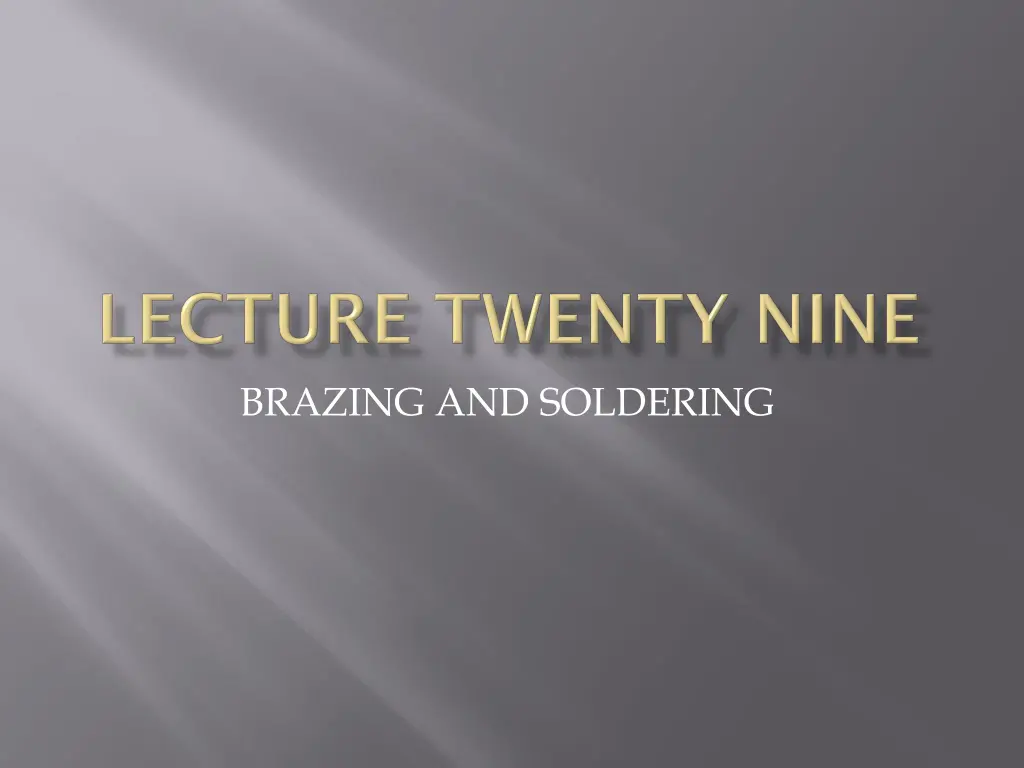
Understanding Brazing and Soldering Processes
Learn about the differences between brazing and soldering, their advantages and disadvantages, applications in various industries, and how these joining processes are utilized in metalwork. Discover the key factors that influence joint strength and aesthetic considerations when using these techniques.
Uploaded on | 0 Views
Download Presentation

Please find below an Image/Link to download the presentation.
The content on the website is provided AS IS for your information and personal use only. It may not be sold, licensed, or shared on other websites without obtaining consent from the author. If you encounter any issues during the download, it is possible that the publisher has removed the file from their server.
You are allowed to download the files provided on this website for personal or commercial use, subject to the condition that they are used lawfully. All files are the property of their respective owners.
The content on the website is provided AS IS for your information and personal use only. It may not be sold, licensed, or shared on other websites without obtaining consent from the author.
E N D
Presentation Transcript
Brazing is a joining process in which a filler metal is melted and distributed by capillary action between the faying surfaces of the metal parts being joined. No melting of the base metals occurs in brazing; only the filler melts. In brazing the filler metal (also called the brazing metal), has a melting temperature (liquidus) that is above 450C (840F) but below the melting point (solidus) of the base metal(s) to be joined . If the joint is properly designed and the brazing operation has been properly performed, the brazed joint will be stronger than the filler metal out of which it has been formed upon solidification . This rather remarkable result is due to the small part clearances used in brazing, the metallurgical bonding that occurs between base and filler metals, and the geometric constrictions that are imposed on the joint by the base parts.
Brazing has several advantages compared to welding: (1) any metals can be joined, including dissimilar metals; (2) certain brazing methods can be performed quickly and consistently, thus permitting high cycle rates and automated production; (3) some methods allow multiple joints to be brazed simultaneously; (4) brazing can be applied to join thin-walled parts that cannot be welded; (5) in general, less heat and power are required than in fusion welding; (6) problems with the heat-affected zone in the base metal near the joint are reduced ; and (7) joint are as that are inaccessible by many welding processes can be brazed , since capillary action draws the molten filler metal into the joint.
Disadvantages and limitations of brazing include (1) joint strength is generally less than that of a welded joint; (2) although strength of a good brazed joint is greater than that of the filler metal, it is likely to be less than that of the base metals; (3) high service temperatures may weaken a brazed joint ; and (4) the color of the metal in the brazed joint may not match the color of the base metal parts, a possible aesthetic disadvantage. Brazing as a production process is widely used in a variety of industries, including automotive (e.g., joining tubes and pipes), electrical equipment (e.g., joining wires and cables), cutting tools (e.g., brazing cemented carbide inserts to shanks), and jewelry making. In addition, the chemical processing industry and plumbing and heating contractors join metal pipes and tubes by brazing. The process is used extensively for repair and maintenance work in nearly all industries.
Soldering is similar to brazing and can be defined as a joining process in which a filler metal with melting point (liquidus) not exceeding 450C (840F) is melted and distributed by capillary action between the faying surfaces of the metal parts being joined . As in brazing , no melting of the base metals occurs , but the filler metal wet sand combines with the base metal to form a metallurgical bond. Details of soldering are similar to those of brazing, and many of the heating methods are the same. Surfaces to be soldered must be pre-cleaned so they are free of oxides , oils , and soon . An appropriate flux must be applied to the faying surfaces, and the surfaces are heated. Filler metal, called solder, is added to the joint, which distributes itself between the closely fitting parts.
In some applications, the solder is precoated onto one or both of the surfacesa processcalledtinning,irrespectiveofwhetherthesoldercontainsanytin.Typicalclear ances in soldering range from 0.075 to 0.125 mm (0.003 0.005 in), except when the surfaces are tinned , in which case a clearance of about 0.025mm (0.001 in) is used . After solidification, the flux residue must be removed. As an industrial process, soldering is most closely associated with electronics assembly (Chapter 35). It is also used for mechanical joints, but not for joints subjected to elevated stresses or temperatures. Advantages attributed to soldering include (1) low energy input relative to brazing and fusion welding, (2) variety of heating methods available, (3)good electrical and thermal conductivity in the joint, (4)capability to make air-tight and liquid-tight seams for containers, and (5) easy to repair and rework. The biggest disadvantages of soldering are (1) low joint strength unless reinforced by mechanically means and (2) possible weakening or melting of the joint in elevated temperature service.






















